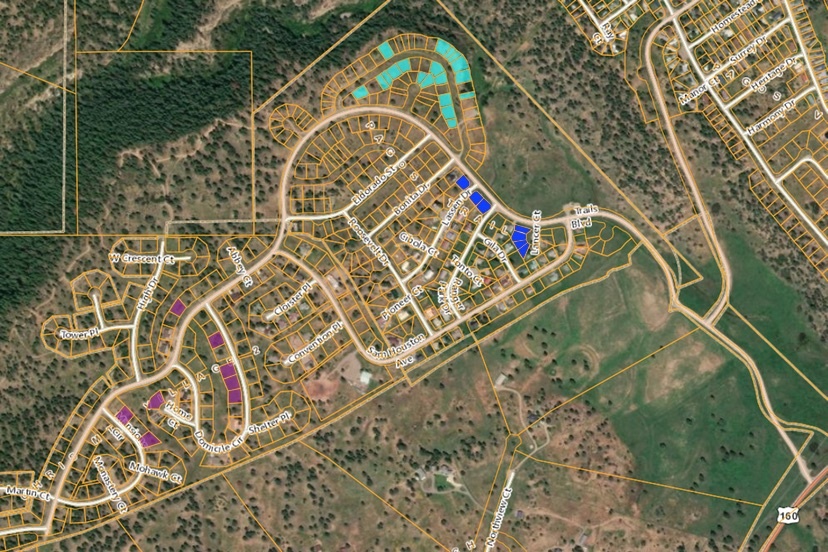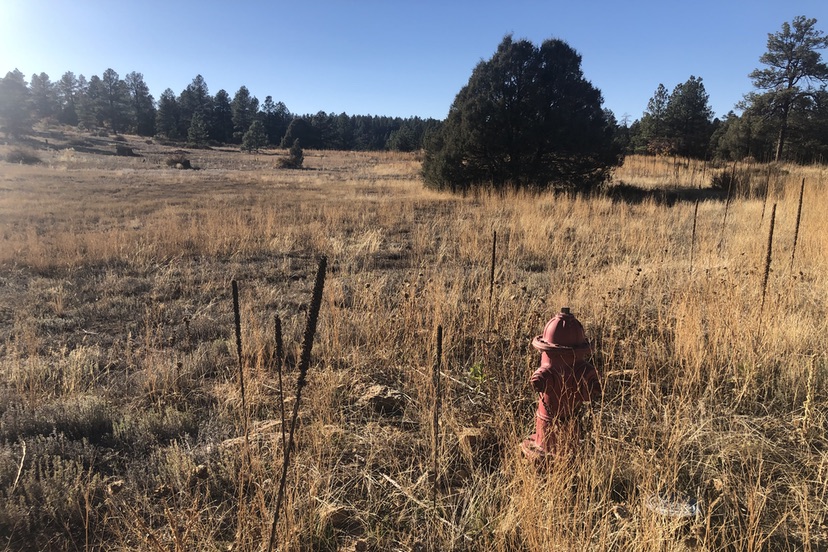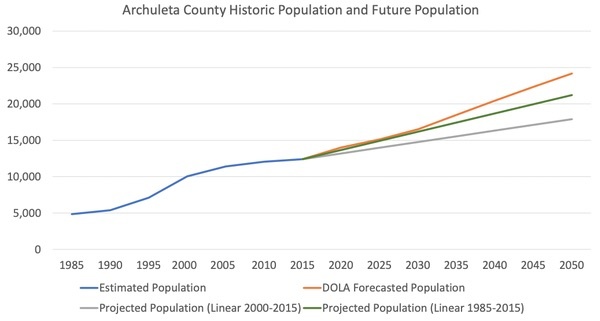PHOTO: Looking across at a dozen platted lots in Pagosa Trails subdivision that Archuleta County offered in a tax lien auction. No one was willing to meet the minimum bid.
I began Part One of this editorial series with a somewhat rhetorical question.
How will our community look and function, in 20 years? Or 30 years?
At the rate things are going…?
I also discussed what I suspect will be a challenging project proposed by the volunteer Pagosa Springs Community Development Corporation (CDC) board, under the leadership of their Executive Director, Emily Lashbrooke: the construction of 35 ‘workforce housing units’ in the Chris Mountain /Pagosa Trails subdivision, on parcels recently donated to CDC by the Archuleta Board of County Commissioners (BOCC).
Most of the vacant parcels donated to the CDC are in the Pagosa Trails subdivision, and I’ve indicated them in the map below in turquoise and blue.
The donated parcels in Chris Mountain II, adjoining the Pagosa Trails subdivision to the west, are shown in purple. (A portion of the Vista mobile home park is visible in the upper right.)

Ms. Lashbrooke told her board, at an October 11 meeting, that the planned homes would likely be priced at $325,000 to $395,000.
In the current American economy and interest rates, a family needs an income of about $120,000 a year to afford a home costing $395,000 (according to Zillow.com)
The median household income in Archuleta County is about $65,000… but the median household income for a working family is about $55,000. (Yes, we have a tourist economy here. Sadly.)
A household income of $55,000 — if you have good credit — will qualify you for a house costing $186,000… assuming you can afford a $30,000 down payment.
All of which suggests that half of our Pagosa workforce cannot qualify for even a $186,000 house. What segment can qualify for a $395,000 house? I leave that to your imagination.
At any rate, it appears that the CDC might be subsidizing homes for comfortably wealthy families. The non-profit CDC has never built a home, nor facilitated construction of one by a private builder. But the BOCC, in its wisdom, has donated 35 vacant lots to the CDC. More about that, tomorrow.
There is, however, a non-profit organization in Pagosa that has successfully built more than two dozen ‘workforce’ homes. Habitat Archuleta is in the process, this fall, of completing three new homes in the Chris Mountain neighborhood. With 30 years of experience and access to a national housing organization, Habitat is able to complete three homes in a year. But they are modular homes, built in Albuquerque and trucked up to Pagosa. (Community members can volunteer to help out. Call (970) 264-6960 or email office@HabitatArchuleta.org before you arrive so we can plan for how many hands will be on deck.)
So I’m thinking about those questions. Where is Pagosa Springs headed, at the rate things are going?
No one can predict the future accurately and consistently. So people who make their living forecasting future conditions often give a ‘range’ of possible outcomes. In 2019, for example, a handful of Pagosa governments wanted to have a reasonable estimate for our community’s population in 2050, to help with long-range planning. With help from the Sonoran Institute, they hired Gabe Preston with RPI Consulting to generate a rational guess about population growth.
After looking at a number of population factors, Mr. Preston gave a range of possible outcomes, based on community history. The high end prediction for Archuleta County was about 24,000 by 2050. Slightly less than double our current county population.
The low end prediction was around 18,000 — an increase of maybe 5,000 people by 2050.
But what Mr. Preston didn’t predict was, who these people are.
Do they comprise a diverse population, or are they a narrow demographic slice?
My crystal ball is dark and cloudy, and doesn’t give a clear picture of the future. But based on my 30 years in Pagosa, and 19 years researching and writing about our community, I believe we have a choice of two likely outcomes for the year 2050. 27 years from now.
On the one hand, there’s an outcome I prefer.
And then, there’s the outcome I sadly expect.
Let’s start with the outcome I expect. 27 years ago, our community leaders — business leaders, government leaders — were considering the best way to keep our three most important industries thriving. Home construction. Tourism. Government.
In order to address the first two categories, a determination was made to attract new people to Pagosa Springs. New people to buy the new homes being built, and new tourists to keep the lodging and hospitality industries happy. (Tourists don’t always come back for a second visit, so a steady supply of new tourists is needed.) It was assumed that the growth of property values and population would keep governments growing, as has indeed been the case.
To support the tourism industry, the Town and County governments have collaborated to provide tax subsidies to improve tourist numbers. About $11.9 million in subsidies have been provided to the tourism industry since 2007. (Not including 2023.)
The construction industry, however, almost vanished completely during the Great Recession, between 2008 and 2010. It has now been partially revived by the current demand for new homes. But due to inflation and numerous other factors, the new homes are typically priced at $395,000 and above. Which suggests that our population is growing, but the new people arriving are comfortably wealthy.
Like, say, millionaires.
These are people who are not working at locally available jobs.
As much as we didn’t want it to happen, Pagosa Springs is on an apparent path to becoming a “millionaires and tourists only” community… like Vail, Aspen, Breckenridge, and Telluride.
At the rate things are going, employers are going to struggle ever harder to find employees… and the employees they do find will be commuting to Pagosa from Chama, New Mexico. If they can even afford homes in that community.
Will workers want a low-paying tourist industry job in Pagosa Springs, if they are required to commute from New Mexico?
That’s another rhetorical question, I suppose.
Then we have the outcome I prefer. A diverse community, where even a young family, starting out, can find a hearty welcome here. That doesn’t currently exist. Young families have been priced out of Pagosa Springs, or forced to live in RVs. But it certainly could happen here, if our community leaders made that a priority.
So let’s look a bit more closely at the vacant parcels in Pagosa Trails/Chris Mountain… that might be a step in the right direction.


